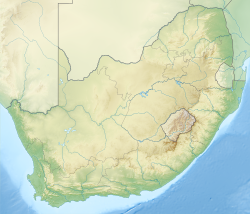| Kalahari Deposits | |
|---|---|
| Stratigraphic range: Campanian-Maastrichtian ~ | |
| Type | Geological formation |
| Lithology | |
| Primary | Conglomerate |
| Other | Mudstone |
| Location | |
| Coordinates | 29°30′S18°24′E / 29.5°S 18.4°E |
| Approximate paleocoordinates | 44°12′S2°18′E / 44.2°S 2.3°E |
| Region | Western Cape |
| Country | South Africa |
| Type section | |
| Named for | Kalahari Desert |
The Kalahari Deposits is an Late Cretaceous (Campanian to Maastrichtian) [1] [2] geologic formation in South Africa. Dinosaur remains diagnostic to the genus level are among the fossils that have been recovered from the formation. [3] The depositional environment is described as a crater lake where poorly lithified, concretionary conglomerate and volcaniclastic, intraclastic, calcareous mudstone were deposited under quiet subaqueous conditions, probably a "crater-fill succession above an olivine-melilitie intrusion". [4]
